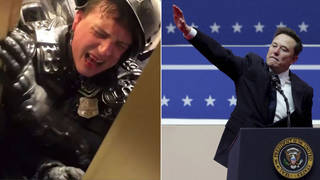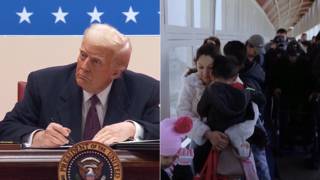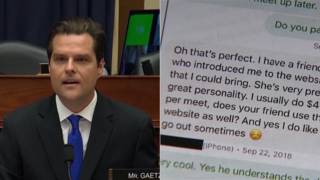
Related
Topics
Guests
- Thomas GeogheganChicago-based lawyer and writer. He is the author of several books, including See You in Court: How the Right Made America a Lawsuit Nation. His forthcoming book is Were You Born on the Wrong Continent?: How the European Model Can Help You Get a Life.
Senate Republicans are currently using the filibuster to paralyze the Senate and derail Democratic initiatives, according a McClatchy Newspapers investigation. Since President Obama took office, Republican senators have used the filibuster to stall legislation on healthcare reform, global warming, and financial regulation and the confirmation of fifteen Obama nominees. Last week, Senators Jeanne Shaheen and Tom Harkin introduced a bill aimed at curtailing the filibuster. Their proposal would gradually reduce the number of votes required to overcome a filibuster, so a simple majority of fifty-one votes could eventually end debate. But Senate Majority Leader Harry Reid dismissed their efforts, noting that changing the rule would require sixty-seven votes. We speak with attorney and writer Thomas Geoghegan, a vocal advocate of ending the filibuster. [includes rush transcript]
Transcript
AMY GOODMAN: On Monday, Indiana Senator Evan Bayh announced his decision to not seek reelection, saying, quote, “Congress is not operating as it should.”
Well, some other Senate Democrats think one of the main problems with the way Congress is operating is the Senate’s abuse of the filibuster, the tactic of delaying and blocking floor votes. Senate Republicans are currently using the filibuster to paralyze the Senate and derail Democratic initiatives, according a McClatchy Newspapers investigation. Since President Obama took office, Republican senators have used the filibuster to stall legislation on healthcare reform, global warming and financial regulation, and the confirmation of fifteen Obama nominees.
Last week, Senators Jeanne Shaheen and Tom Harkin introduced a bill aimed at curtailing the filibuster. Their proposal would gradually reduce the number of votes required to overcome a filibuster, so a simple majority of fifty-one votes could eventually end the debate. But Senate Majority Leader Harry Reid dismissed their efforts, noting changing the rule would require sixty-seven votes.
Appearing on CBS’s Face the Nation with Bob Schieffer Sunday, Vice President Joe Biden described the Senate’s abuse of the filibuster as the worst he’s ever seen.
VICE PRESIDENT JOE BIDEN: Most people would agree that the United States Senate has never acted as consistently as they have to require a supermajority — that is, sixty votes — to get anything done. That’s a fundamental shift. I was there for thirty-six years. I don’t ever recall it being abused and used as much as it has now.
AMY GOODMAN: Well, my next guest, Chicago-based lawyer Thomas Geoghegan, has been a vocal advocate of ending the filibuster. In a recent op-ed in the New York Times and an editorial in The Nation magazine, Geoghegan describes Senate Republicans’ use of “ghost” or “procedural” filibusters as unconstitutional. He warns it’s silenced debate and will jeopardize the Obama presidency. Thomas Geoghegan is the author of See You in Court: How the Right Made America a Lawsuit Nation.
Welcome to Democracy Now!, Thomas Geoghegan. Lay out how the filibuster works today, why we hear so much more about “Well, can we get sixty votes?” than we did when the Republicans are in power, who seemed to be much more concerned about getting fifty-one.
THOMAS GEOGHEGAN: Well, Amy, the modern procedural filibuster, or “ghost” filibuster, or a filibuster without filibustering, began in 1975 when the old talking filibuster rule was changed to allow the Senate to put a cloture on debate with sixty, instead of sixty-seven, votes. But what happened was that the practice of having senators filibuster just lapsed. The majority leaders of the Senate, especially the Democratic majority leaders, let the minority pretend or threaten to filibuster, and then everyone operated on the basis that there was a pretend filibuster going on. And the question then became whether you could cut off this filibuster, where there’s no Jimmy Stewart out there filibustering it. That was the big change, and that’s why it’s gone from a practice of four or five a congressional term to something like 130 a congressional term.
AMY GOODMAN: Can you explain, Thomas Geoghegan, the history of the filibuster?
THOMAS GEOGHEGAN: Well, it’s a tangled history. There was no filibuster when the Founders put the Constitution in place in 1787. And when the first vice president sat as the presiding officer of the Senate, a man who happened to be Thomas Jefferson, and wrote a manual of Senate procedure, a simple majority could cut off debate. But Aaron Burr — remember Aaron Burr, who shot Alexander Hamilton? — well, he allowed unlimited debate. There was no rule for cutting off debate, but the rule wasn’t abused in any serious way, until the early twentieth century, when in 1917 there was a rule put in to put a cloture, or end unlimited debate, a two-thirds rule. This was in 1917.
But again, a talking filibuster was rarely used in the Senate. The Senate term could only accommodate three or four of these at the most, because you effectively had to, like in the Jimmy Stewart movie, shut down the whole government. So these were very rare and infrequent and mainly used by Southern senators on Jim Crow laws and so forth. They were embarrassing to the Senate. Look at the Jimmy Stewart movie. It was an embarrassment. So they changed the rule to try to get rid of filibusters altogether.
But at the time they changed the rule in 1975 to get rid of filibusters altogether, the Senate majority leaders, for some reason, just began as a “gentlemanly,” quote-unquote, sort of thing to let the debate be a pretend debate, so that no one would be embarrassed. And that made it much easier for the minority to use. And that’s why it’s gone up from something that was a rare, paralyzing, shutdown-the-government event once in awhile to something that is used routinely now on every contested bill.
AMY GOODMAN: Thomas Geoghegan, what did —-
THOMAS GEOGHEGAN: And it’s turned the Senate into a supermajority.
AMY GOODMAN: Explain the supermajority.
THOMAS GEOGHEGAN: Yes. Well, the supermajority -— the Constitution is set up for majority rule in both houses of Congress. There are enough checks and balances on majority rule that you don’t need a supermajority, except in certain cases where the Founders in the Federalist Papers, and I mean Madison and Hamilton, with obvious guilt, explained why, on a treaty or on expulsion of a member of Congress, you have to have a supermajority, a two-thirds vote. But there’s no sixty-vote rule anywhere in the Constitution. And in Federalist No. 75, if anyone wants to look up their Federalist Papers, and in other essays in the Federalist Papers, Hamilton, Madison, explaining the Constitution, say that supermajorities would paralyze the operation of the government.
So the Constitution has only specific occasions where a supermajority can be used, and it specifically says that the vice president of the United States, as presiding officer, is the tie-breaker of the Senate, quote, “when the Senate is equally divided,” unquote. That means 50-50. So, fifty plus one vice president is the majority rule under which the Senate is supposed to operate, according to the Constitution. And today, it is sixty votes, because it takes sixty votes, sixty senators, to cut off a pretend filibuster where nobody is really filibustering, and effectively to enact the bill into law. A complete violation of the Constitution.
AMY GOODMAN: Thomas Geoghegan —-
THOMAS GEOGHEGAN: And -—
AMY GOODMAN: Yes, go ahead.
THOMAS GEOGHEGAN: Amy, there’s another provision it violates. If you look at Article I, Section 5, those of you who have their Constitutions out, you’ll see a rule that the Founders were very proud of. It’s a rule that says a majority of legislators constitute a quorum. Normally it’s two-thirds. But the Founders were so frightened that there be supermajority rule in either the House or the Senate that they put in this special procedural rule, which says only a majority is enough to constitute a quorum and enact a bill.
Why is that? It’s not just because it was a long time to get the stagecoach by Washington and people might not show up. It’s because the Founders were afraid that a minority, under a two-thirds rule, could just walk out of the House or the Senate and block the enactment of a bill, the appointment of a presidential nominee — in other words, to do exactly what’s going on right now through the use of the procedural or pretend filibuster. So this is all blatantly unconstitutional.
AMY GOODMAN: What about those who argue that it’s the filibuster that saved the country from Bush?
THOMAS GEOGHEGAN: Well, it didn’t. And one of the things that the filibuster did is it delivered the country to Bush. You know, the filibuster has been used over and over to frustrate — well, I’m a labor lawyer, Amy, so three times there’s been a frustration of the filibuster, it’s passed the Senate by a majority, but not a supermajority. So we don’t have labor law reform, we don’t have unions, we don’t — we have more inequality, people don’t have pensions. And, you know, my friends go around talking about “Oh, globalization, globalization.” I want to say to them, “And Senate Rule 22.” You know, if — it is the filibuster that frustrated the Carter agenda, that frustrated the progressive side of the Clinton agenda, that delegitimates the Democratic Party. People look at Barack Obama right now and say, “Well, he can’t get anything done. We’re frustrated with him. We’ll vote in the Republicans.” It is the filibuster that keeps delivering the country to the Republicans, because the Democrats, thanks to the filibuster, are unable to govern. That’s the horror of the thing. And the worst part is to have progressives turn around and say, now that the country is back in the hands of the Republicans, thanks to the filibuster, which has blocked labor law reform and healthcare and everything else, “Isn’t it a good thing we have the filibuster, because now we can stop Bush?” I mean, it makes no sense. This is a horrible thing for progressives.
The Senate exists, thanks to the filibuster, historically, for two things. One was, originally, to protect slavery. And the second is to protect kind of low-wage labor. That’s its basic function. And it is the main reason that we have this great inequality in the country today. We don’t have one person, one vote in our country. We have the Senate rule where two senators from a state with 600,000 are equal to California with 36 million. It’s not small states versus big states. It gives the conservative states an enormous veto over everything that could occur when a progressive majority takes over the presidency and the Congress.
AMY GOODMAN: What about the idea of that it protects the minority party?
THOMAS GEOGHEGAN: Well, it doesn’t protect the minority party. In some ways, I think it tears apart the minority party. Look at the tea party right now in the Republicans.
You know, when you have majority rule, what does that mean? It means that the minority party has to compromise. It has to govern with the progressives, because they can’t stop them.
If you have a situation in which you’ve got the Weimar Republic brought back again, you know, you can completely polarize and shut down the administration. It pulls — it pulls apart the opposition and pushes it, in my view, further and further to the left — further to the right, I mean. You know, it just — it puts the Republican Party in the hands of the extremists, because they know they can shut down the government, discredit Barack Obama. They’ve seen how the filibuster worked with Carter, discredited him, saw how it worked in the Clinton administration the first two years when the Democrats had a majority, discredited him. They know they can bring down the government this way. And when you give the power to a minority to bring down the government, it’s going to be exercised irresponsibly.
We used to have in this country, in the 1940s and 1950s, you know, some kooks on the Republican side, but fairly responsible opposition party, you know, in a certain way. There was a lot of bipartisanship, especially on foreign policy. But, you know, you even had Robert Taft proposing federal housing programs for people. It was a party that had to find its way to the center, because there was a center-left that was able to govern.
AMY GOODMAN: We only have a minute —-
THOMAS GEOGHEGAN: When that can happen -—
AMY GOODMAN: We only have a minute to go, Thomas Geoghegan.
THOMAS GEOGHEGAN: — things get worse.
AMY GOODMAN: But what do you think they should do in Congress right now? And what do you think Harry Reid should do?
THOMAS GEOGHEGAN: I think that we should let the filibuster be the filibuster. If we can’t get rid of it through court or have the Vice President declare it unconstitutional, as presiding officer, which Joe Biden should do, let the filibuster be the filibuster. If they want to obstruct, let them obstruct. Bring up the minor appointees, and let them shut down the Senate for weeks and weeks and weeks. Let people see how ridiculous this is. Let’s go back and have the replays of the Jimmy Stewart movies, and I think the country will be disgusted. The procedural filibuster will be gone. The old talking filibuster will be back. It will be discredited. And we’ll move on and begin governing the country again.
AMY GOODMAN: Do you think the Democrats rely on the threat of the Republican filibuster, because they don’t want to move forward on the kinds of issues you’re concerned about?
THOMAS GEOGHEGAN: Well, some do. But I think the majority, really for ego and vanity reasons, love the filibuster. You know, there are all sorts of progressive senators on the left who love it. And the reason is, it gives one senator enormous power to put a procedural hold on an appointee. And I have to say, there is no better way to raise money for a senator than to go around to contributors and saying, “Hey, I single-handedly can shut down the whole country,” which, as the rules now operate, they can do. So people — it’s a lot easier to buy one or two senators to put procedural holds on things than to buy fifty senators to block the whole nominee. You know, it’s a very insidious system.
AMY GOODMAN: Five seconds.
THOMAS GEOGHEGAN: It’s extremely corrupting.
AMY GOODMAN: Thomas Geoghegan, I want to thank you for being with us, is a lawyer based in Chicago, author of See You in Court: How the Right Made America a Lawsuit Nation.













Media Options